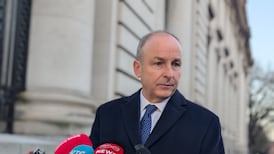Taoiseach Micheál Martin is to meet Opposition leaders to seek an all-party consensus to deal with the crisis in the Supreme Court, following the suggestion from Chief Justice Frank Clarke to Mr Justice Séamus Woulfe that he should resign.
It is widely expected throughout the Government and Opposition that this is likely to lead to a process which could see Mr Justice Woulfe removed from office by votes in the Dáil and Seanad.
The unprecedented crisis in the judiciary moved into the political realm yesterday, as the possibility of an impeachment process was widely discussed among Government and Opposition politicians.
Attorney General Paul Gallagher briefed the Cabinet yesterday on the “serious constitutional issues” given rise to by the differences between the Chief Justice and Mr Justice Woulfe over his attendance at the Oireachtas golf dinner and his subsequent response to the controversy. Under the Constitution, a judge can be removed from office by votes of the Dáil and Seanad for “stated misbehaviour or incapacity”.
Consider the correspondence
In a statement after the weekly Cabinet meeting, the Government said it would consider the correspondence between Mr Justice Clarke and Mr Justice Woulfe which was published on Monday night.
“The members of the Government, who are also members of the Oireachtas, are acutely aware of the sensitivity and seriousness of the issues and the need to ensure that the constitutional framework is fully respected by all concerned. This includes avoiding inappropriate public comment,” the statement said.
“The Government agreed that it will continue to reflect on these issues.”
Behind the scenes there are intensive discussions in Government on the way forward. However, there is a growing sense in Leinster House and in Government circles that it will be very difficult for Mr Justice Woulfe to remain as a member of the Supreme Court given the comments by the Chief Justice and the views of other members of the court. There was no support expressed for him at Cabinet, it is understood.
Impeachment process
Later, in a signal that an impeachment process under article 35 of the Constitution was becoming increasingly likely, the Ceann Comhairle warned TDs to exercise “the utmost care in any comments” they make in relation to the affair.
Sean Ó Fearghaíl said it was “crucial” that TDs “do not comment on the matter, either on the floor of the House or elsewhere in such a way as could give rise to a perception of bias”. He said “this could act as a serious impediment to their ability to discharge their important constitutional functions”.
TDs in all parties were cautious in their comments on the issue yesterday, though Rise TD Paul Murphy, who has previously called for Mr Justice Woulfe to resign, said the Rise-Solidarity-People Before Profit grouping would probably decide today whether to put down a motion seeking to remove him under article 35.
If a motion – which can be submitted by any TD – to remove a judge is put before the House, TDs must vote either to accept or reject it.
If it is voted through, a special committee will be set up to investigate the accusations against the judge, though it cannot make any findings or recommendations. The committee’s report would then inform a process in the Dáil in which the judge, and his legal representatives, would be entitled to address TDs in his defence, before a vote on his removal takes place.









